Today, we travel to the deserts. Or, actually, the deserts travel to us. What happens if dust swallows up over 30% of the planet?
Guests:
- Sumant Nigam: climate researcher at University of Maryland
- Morgan Gorris: PhD candidate at UC Irvine
- Christina Xu: freelance technology researcher
- Lindsay C. Stringer: researcher on land use and sustainability at the University of Leeds
- Matthew Bowker: soil ecologist at Northern Arizona University
Further Reading:
- As air pollution gets worse, a dystopian accessory is born ← My piece on face masks mentioned in the episode!
- Twentieth-Century Climate Change over Africa: Seasonal Hydroclimate Trends and Sahara Desert Expansion
- Monitoring desertification risk through climate change and human interference using Remote sensing and GIS techniques
- The next dust bowl
- Assessment of the relative role of climate change and human activities in desertification: A review
- Sources of Asian dust and role of climate change versus desertification in Asian dust emission
- What Has Caused Desertification in China?
- Climate change, drought and desertification
- Drought-sensitivity of fine dust in the US Southwest: Implications for air quality and public health under future climate change
- Dust Storms Impacts on Air Pollution and Public Health under Hot and Dry Climate
- Coccidioidomycosis Dynamics in Relation to Climate in the Southwestern United States
- Dust in the wind: Long range transport of dust in the atmosphere and its implications for global public and ecosystem health
- Crossing the Line: Human Disease and Climate Change Across Borders
- Climate change-induced migration and violent conflict
- Desertification, Refugees and Regional Conflict in West Africa
- Governing Global Desertification
- Climate Change and Migration: Rethinking Policies for Adaptation and Disaster Risk Reduction
- Adaptations to climate change, drought and desertification: local insights to enhance policy in southern Africa
- Adaptation to climate change and desertification: Perspectives from national policy and autonomous practice in Malawi
- Biocrust-forming mosses mitigate the impact of aridity on soil microbial communities in drylands: observational evidence from three continents
Actors:
- The Snowglobe Narrator: Brent Rose
- Lenny Haywood: Evan Johnson
- Farah Mousterian: Zahra Noorbakhsh, host of Good Muslim, Bad Muslim
- John Jacob Siwa: Joseph Jones
- Juana Aguilar: Tamara Krinsky, host of Tomorrow’s World Today
- Amy Trisol: Ariela Morgenstern
Flash Forward is produced by me, Rose Eveleth. The intro music is by Asura and the outtro music is by Hussalonia. The episode art is by Matt Lubchansky. Special thanks this episode to the Women Audio Mission studios, Maryam Qudus, Stephanie Lopez, The Potluck Podcast studio, the Potluck Podcast Collective and Quincy Surasmith.
If you want to suggest a future we should take on, send us a note on Twitter, Facebook or by email at info@flashforwardpod.com. We love hearing your ideas! And if you think you’ve spotted one of the little references I’ve hidden in the episode, email us there too. If you’re right, I’ll send you something cool.
And if you want to support the show, there are a few ways you can do that too! Head to www.flashforwardpod.com/support for more about how to give. But if that’s not in the cards for you, you can head to iTunes and leave us a nice review or just tell your friends about us. Those things really do help.
That’s all for this future, come back next time and we’ll travel to a new one.
FULL TRANSCRIPT BELOW
▹▹ ▹▹ ▹▹ ▹▹ ▹▹ ▹▹ ▹▹ ▹▹ ▹▹ ▹▹ ▹▹ ▹▹ ▹▹ ▹▹ ▹▹ ▹▹ ▹▹ ▹▹ ▹▹ ▹▹ ▹▹ ▹▹ ▹▹
Rose: Hello and welcome to Flash Forward! I’m Rose, and I’m your host. Flash Forward is a show about the future — what might happen tomorrow? What might NOT happen tomorrow? Or in ten years? Or a hundred? Every episode we tackle a different future, everything from space pirates to living underwater, to just… giving everybody money. For every future, we start with a little field trip to tomorrow, to check out what’s going on. And then, we teleport back to today, to talk to real experts about what that future might really be like. This is the third episode in our little mini-series about EARTH, we have two more, and then a bit of a break.
Got it? Great!
Thanks to PNAS Science Sessions for supporting this episode of Flash Forward. Today, take five minutes and learn something new about the physical, social, and natural worlds from the frontiers of science. Subscribe to Science Sessions on iTunes, Spotify, Google Play, Stitchr, or wherever you get your podcasts.
Today we’re starting in the year 2095.
[[music up]]
Narrator: Everybody thinks they’re on the verge of the next million dollar idea. But do they have what it takes to really make it big? It’s time to find out. Real entrepreneurs. Real investors. Real success. But don’t expect anything warm and fuzzy. Welcome to THE SNOWGLOBE. Let’s meet the bears.
Lenny Haywood, a renegade entrepreneur and billionaire who not only owns the Seattle Supersonics, but also plays for them.
Lenny Haywood: Money is a scoreboard where you can rank how you’re doing against other people. I’m a winner, and I know a fellow winner when I see one.
Narrator: Farah Mousterian: the daughter of Iranian immigrants who went on to become a technology mogul like the world has never seen, selling her first startup for 4 billion at the age of 15 and never slowing down.
Farah Mousterian: Once you have found out what you love to do, there is only one goal: to be the best in the world at it. I’m looking for those people, the people who can be the best with just a little push.
Narrator: John Jacob Siwa, a fashion icon turned fashion mogul who doesn’t just walk the runway, he owns it, literally.
John Jacob Siwa: The most important thing in business is to align yourself with the right people. I’m the right people.
Narrator: And Juana Aguilar, a venture capitalist who has taken hundreds of businesses under her wing to form the world’s largest and most profitable corporation conglomerate worth nearly a trillion dollars.”
Juana Aguilar: People ask, ‘Are entrepreneurs born, or are they made?’ I think it’s a combination of both. Your mom already took care of the birthing part, and I can make you.
Narrator: The bears will hear from the world’s best, brightest and savviest inventors. For some, it will be heartbreaking
Roberta: It’s not paranoia, it’s science!
Lenny: Are you kidding me?
John: She’s trying to rip you off!
Amy: Can you give me a second to think, please?
Farah: Oh my god we’re all going to die.
Narrator: For others, it will turn into the opportunity of a lifetime.
John: These are nice!
Kevin: This is the future of building ladies and gentlemen!
Christina: Who wants to dive in, the water’s empty!
Farah: We’re going to make some money before society collapses girls!
Let’s step into the globe. [[whoosh]]
[[[music fafdes out]]
[[[entrepreneur walks in]]
Amy Trisol: [Nervous but excited]: Hi. I’m Amy Trisol.
I have in this box, two sets of human lungs.
Farah: Oh boy.
Amy: One of them is normal. This one. [opening flap, showing it]
Amy: And one of them is not. This one.. [opening box showing it]
Juana: Ugh [grossed out noise]
Amy: This second set of lungs is what happens when you spend your entire life breathing tiny particulate matter otherwise known as dust. And as you all know, dust has become a huge problem all around the world.
This is a map of The Sahara desert in 1902. And here’s the Sahara today. This is a map of the Gobi desert in 1975 And… here’s today. Here’s the Sonoran Desert in 1962, and … here’s today.
But you don’t need my fancy maps to tell you this right? You probably noticed the dusty air on your walk into this building today. Well, let me tell you, it’s not going to get better. Experts say that the deserts and dry spots are just going to get bigger in the next twenty years.
So, you could just stay inside forever… but that seems pretty boring right? Plus, you have businesses to run! And that, is where the FLORRUM comes in. FLORRUM is a state of the art respiration system the protects your lungs from the damage that dust can do.
Masks sort of like these are already really popular in places like Japan, Korea and China. But they haven’t quite made it beyond Asian markets. That’s because companies here haven’t taken the time to actually figure out what styles American and European consumers want. Right now the options for masks in the US is … I’m just going to say it, it’s ugly. They’re tactical, they’re military, they’re functional but… they look terrible. Juana do you really want to show up to work wearing this?
Juana: Depends on what mood I’m in.
Amy [nervous laugh]: Well my market research suggests that most people wouldn’t really want to go to the movies or work or to pick up their kids wearing this. And parents are going to buy these for their kids too by the way, not only is dust damaging on its own, it can also bring with it diseases like valley fever and whooping cough.
I’ve spent the last two years doing market research and developing FLORRUM into a line of fashion forward masks that people actually WANT to wear. Think of these like handbags for your face, you probably want a couple to match your outfit. Or, for the men, ties. You don’t have just one tie, right? You have a couple, so you can look snappy.
And with these designs I’ve had success. Since starting the business two years ago I’ve made $1.2 million. With the recent fires in the West this year I’m on track to triple our normal annual income. And demand is only going to go up as deserts around the world continue to expand and swallow up towns and cities. This is already a huge untapped market, and with your help I think we can totally corner it.
[pause]
So, um, I’m asking for $350,000 for 10% of the company.
Juana: How much do these sell for?
Amy: $39.99 for the basic models, and up to $54.99 for some of the higher end designs.
Juana: And how much do they cost to make?
Amy: $5 to $7, depending on the finishes.
John: [impressed] Nice. Can I hold one?
Amy: Oh sure, of course, here, take your pick, you can all have one.
John: This feels nice [puts it on]. [sort of muffled] How do I look?
Juana: You look cute! Not as much like a bank robber as I expected. And you said you have kid sizes too?
Amy: [eager] Yes, we have kid sizes, they’re actually some of the most popular ones.
John: Do you have a patent?
Amy: No, I don’t.
John: Why not?
Amy: I’ve been focused on sales — this whole business is just me, so, there’s only so much I can do really.
John: [sharp] Never say that to an investor. I want to know that you’re willing and able to do it all.
Juana: $350,000 for 10%, you said?
Amy: Yes
Juana: So you think this is a 3 million company?
Amy: I think it’s worth more. The age of dust is upon us.
Juana: Then why not ask for more?
Amy: um, well I wanted a deal.
Farah: I’m also out. Fashion bores me.
Juana: Seriously guys? You realize that undervaluing herself means we potentially get a great deal? $350,000 for 20%
John: Whoa whoa whoa, you’re going to give her 20% of the company you think is actually worth way more? She’s trying to rip you off!
Juana: Hey she came up with the numbers not me.
John: $200,000 for 10%. If you think the company is worth so much, don’t give too much of it away.
Juana: $300,000 for 15%
Amy: oh wow.
John: Hey remember I’m the fashion guy, I can get you into REI, Walmart, Target, you name it and I can get your product on the shelves.
Juana: [cutting him off] Can you really ramp up to Target level production with just $200,000 though?
Amy: can you give me a second to think please?
[pause]
Amy: Um, okay, yeah, John, deal, $200,000 for 10%.
Juana: Oh come on!
John: [triumphant] Hah! Great choice. I look forward to doing business with you Amy. Can I keep this one?
Also I want one in gold. Like actual gold.
[music up]
Rose: Okay! So, when it comes to climate change, a lot of the focus is on sea level rise. Cities underwater. Devastating storms like Hurricane Katrina or Hurricane Sandy. And all of that is real and important to talk about. But the opposite will happen, too — some places that aren’t swallowed by water, will be swallowed by Sand. While the coasts might live in Water World, the rest of us might wind up living in Dune.
So today we’re headed to the desert. Or actually the desert is headed to us.
Sumant Nigam: The desert is creeping but nobody’s noticing.
Rose: This is Sumant Nigam, a climate scientist at the University of Maryland.
Sumant: It’s not an event that announces itself like the hurricane, that we focus on. There is no focusing here. It’s a relentless, but a slow march. And in the end it will swallow you.
Rose: Sumant recently published a study along with his graduate student, Natalie Thomas, documenting the growth of the Sahara Desert over the last 100 years.
Sumant: What we found is that the Sahara Desert has expanded significantly since the 1920s by about 8 to 10 percent
Rose: Now, 8 to 10 percent over 100 years might not sound like that much. But there are a couple of important details here. First, the Sahara is really big. Like, the size of the United States. Ten percent of something that big, is a lot!
But more importantly, this expansion is happening in ways that people didn’t expect. It’s actually pretty normal for a desert like the Sahara to expand and contract over the course of a year.
Sumant: Africa has growing season, an agriculturally productive season beginning in late spring, summer, fall.
Rose: During the wet season, the desert contracts.
Sumant: Sahel has a rainy season in June, July, August.. So when Sahel has a rainy season. The desert is pushed to the north.
Rose: You might remember that we talked about the Sahel in the first episode in this mini-season. It’s that band that separates the Sahara from the Savanna. So when it’s wet, the Sahara shrinks, and the Sahel expands. And when it’s dry, the opposite happens, the Sahel shrinks and the desert expands. This happens every year, the desert kind of… breathes, in and out.
But what Sumant found was that overall, little by little, the desert is getting bigger. And the most surprising part, is that he found that the Sahara is getting bigger in the summer.
Sumant: And that’s very consequential, because summer is the rainy season. It’s the growing season that’s when all the crops are planted.
Rose: This is extra bad, not only is the desert expanding, eating away at the land around it, but it’s getting bigger exactly when it’s supposed to be shrinking. And exactly when the local people need the desert to be shrinking.
Sumant’s paper also gets more specific. They show exactly where the desert is creeping further South.
Sumant: Our analysis indicates that Mauritania in West Africa, and Chad and Sudan more in the middle and to the east, are going to bear the brunt of the desert advance southward.
Rose: I’ll post some of the maps from this paper on FlashForwardpod.com if you want to look at them.
Another cool thing about this paper is that Sumant and his team were able to analyze a hundred years of data, which is a span of time longer than the natural climate cycles that might drive something like a dry spell. Which means they were able to show that this expansion is unusual, and driven by climate change.
Sumant: Taking the long view is very interesting and very important in science for our credibility; that we are able to make a meaningful attribution to climate change after factoring for natural cycles.
Rose: And the Sahara isn’t the only desert that’s been creeping. The Gobi desert, in China, has been expanding by almost ten miles every year. The Kalahari Desert, in Southern Africa, the Maowusu desert in China, the Great Sandy Desert in Australia, and the deserts in the Southwestern United States are all creeping further and further outwards. And climate models suggest that at our current rate of climate change, deserts could expand by 34% globally. That’s 5.2 million square miles that the deserts could swallow up.
So what’s next? What happens if the deserts really do continue to seep out further and further, and our planet becomes a dust bowl? That’s the big question on today’s episode, and when we come back, we will talk about what a Dune world might mean for public health, global conflict, and food security.
[[AD FOR PNAS PODCAST]]
Rose: Okay so the deserts are expanding all over the world. But who cares? What’s a little dust!? Well.. you should care! Because for one thing, dust can sometimes come with some uninvited guests.
Morgan Gorris: They could possibly be hitching a ride with the dust. We haven’t been able to study that fine of a transport mechanism with these spores; they’re so small that they can travel a good distance.
Rose: This is Morgan Gorris, a Ph.D. candidate at UC Irvine. And the spores she is talking about, are the spores of a fungus. If you inhale those spores, you can get something called valley fever.
Morgan: Valley fever is an infectious fungal disease that’s found in desert areas. In the United States it’s found in the southwestern United States, and also parts of Washington state. And it’s also found in Central and South America.
Rose: For some people, valley fever is no big deal.
Morgan: Only about 40 percent of people who actually contract the disease will show symptoms.
Rose: But for other people, and often those who are already immunocompromised, or young kids, or older people, it can get a lot worse.
Morgan: Symptoms first start like the flu. You’ll have a rash and fever, and then it can actually develop further. And if the fungus disseminates throughout your body or spreads to other parts of your body, it can become very nasty and cause things like skin lesions, where you have these sores on your skin, or even move to your brain and cause swelling of the brain and can unfortunately become fatal.
Rose: The spores that cause valley fever come from a fungus that grows in desert soil.
Morgan: It acts as a decomposer, so it likes to eat decaying animals, especially keratin which is found in your hair and your nails.
Rose: But when there’s nothing around to eat, the fungus moves. And it moves by breaking apart into tiny, tiny spores and floating through the air.
Morgan: And these spores can become lofted into the air with any type of soil disturbance, so if there’s high winds, or a dust storm, or if you are shovelling into the earth and cause a plume of dust, these spores can become airborne
Rose: And once they’re airborne, they can find their way into our lungs.
Because the symptoms of valley fever can take a while to show up, it can actually be hard to link things like dust storms and cases of valley fever. But there are cases where scientists are pretty confident that a big influx of dust caused an outbreak.
Morgan: There have been situations where a large dust storms have come across the Phoenix metropolitan area, and then in the following few months we see a large increase in cases.
Rose: Researchers suspect that as the United States dries out and gets hotter, they’re going to see more cases of valley fever because there’s simply going to be more habitat for the fungus to grow in.
Morgan: So this combination of increasing temperatures, and decreasing precipitation or decreasing rainfall in a lot of these areas might allow valley fever to move further north.
Rose: And it’s not just valley fever that is linked to dust. There’s also something called Kawasaki disease that seems to be linked to the movement of dust across the planet.
Morgan: And this disease… we’re unsure of what is that causative agent for this disease, whether it’s a virus or bacteria. But there have been cases in Japan and in San Diego, and it seems that these cases are linked to these global winds.
Rose: So, Kawasaki disease is so fascinating and weird. It was discovered over 40 years ago, but like Morgan said, we literally do not know what causes it — a fungus, a bacteria, who knows! But scientists do know that it enters into humans through our mucous membranes, and can work its way into the arteries of mostly young children. The initial symptoms, things like fever, rashes and swollen hands and feet, often fade after a while. But Kawasaki disease can leave behind this, kiss of death. In some cases, the infection alters the heart, and can lead to heart disease and heart failure years later.
And researchers have linked cases of this disease with these global winds — winds that move from Central Asia to Japan, and then across the ocean to the Western Coast of the United States.
Morgan: So these global wind patterns might be pushing this disease from, we think, the Asian coast to the coast of California.
Rose: And in some parts of Africa, expanding deserts might come with other disease risks.
Morgan: There are also epidemics, or large case numbers, of meningitis in Africa that happen when there’s low humidity and large levels of dust. And then they disappear when the rain starts. So we think that meningitis in Africa happens with these dusty environmental conditions.
Rose: So a world with 30 percent more deserts, means a world probably with more of these diseases. But even if you don’t live in a place with valley fever or meningitis or Kawasaki diseas, dust is still a public health problem.
Morgan: Dust itself is pollution. It’s a type of air pollution, and the Environmental Protection Agency recognizes dust as air pollution. And it falls into a category called particulate matter.
Rose: The EPA classifies two different types of particulate matter, and they organize these types by size. There’s stuff that’s bigger than 2.5 microns, and stuff that’s smaller than 2.5 microns. And it’s the small stuff, the stuff smaller than 2.5 microns, that you really have to worry about.
Morgan: And these particles are so small that you can fit over twenty of them across the width of a human hair. So these particles are so small that when you inhale them they can actually get into your bloodstream. And they can cause a lot of health effects for people
Rose: These tiny dust particles can cause all kinds of respiratory issues, especially for people who already have compromised lungs or hearts. And Morgan says that overall, it might be this regular old dust that we should worry about more than the diseases they might carry.
Morgan: So, if you’re a healthy individual you might not show symptoms of valley fever, but you still might have a lot of aggravation in your lungs from the overall levels of dust in the atmosphere.
Rose: But it’s also hard to avoid dust in the atmosphere, it’s everywhere, and it’s often invisible, and … we do kind of have to move around in the world.
Morgan: It’s just impractical to tell people, “don’t go outside, don’t breathe.”
Rose: And this was actually the inspiration for the introductory scene that you heard on today’s episode on the snowglobe. Because I actually do think that face masks, masks that protect us from dust and pollution and fungal spores and all that, are going to get more common.
I live in Berkeley now, and last year there were two huge fires in California. One of them, the Camp Fire, was up near me, covered 153,336 acres, destroyed nearly 20,000 structures, and it killed 85 people. And in the weeks during and after the fire, there was this really thick layer of smoke in the air in Northern California. And going outside was like stepping into a dystopian movie. The sky was this low, thick, grey color and even at midday the sun was this, red alien-like orb. Schools were cancelled all over and people mostly stayed inside, so the streets were conspicuously empty. And the people you did see outside were almost all covering their mouths somehow — either with painters masks, or bandanas, or scarves, or just their shirt, or what have you. And stores all over the entire region totally sold out of the masks that actually filter out those dangerous, tiny particles, the ones smaller than 2.5 microns.
Smoke from fires isn’t quite the same thing as dust from deserts, but the short-term solution is the same: wearing an air filtration masks. And seeing all these people walking around wearing these white, kinda ugly, painters masks got me thinking about the future of the air filtration mask as a fashion item.
Christina Xu: We’re really good, I think, as people, at incorporating whatever it is you have to wear into statement pieces and fashion eventually.
Rose: This is Christina Xu, a freelancer researcher who studies cultural trends in the US and China. And I called Christina because I found out that she has a Pinterest board just for interesting looking face masks.
Christina: For me, I guess it is a piece of speculative pinteresting, if that makes sense, about this idea of masks as fashion. And just trying to collect it as if it were a fashion item.
Rose: So in places like China and Korea, wearing masks around is relatively common. But they’re not the kinds of masks that we’re talking about here, they don’t filter out those tiny particles.
Christina: They are more meant as surgical masks. So people wear them in Japan and in Korea, and eventually in China, as a way to protect other people from their germs, or to protect themselves from other people’s germs in crowded places like the subway or in the workplace. So it’s considered a polite thing to wear if you’re sick.
Rose: These are sometimes called courtesy masks, and they’re common in places like Korea in part because of the density of living there.
Christina: Almost like wearing gloves on the subway. Something where you’re just protecting yourself from this hyper dense, hyper concentrated, urban environment. Which, frankly, there are just more of those places in China, and Japan, and Korea, and in Asia, in general than there are in the US, where we tend to be a little bit more spread out, except for the coasts.
Rose: In places like Beijing and Delhi, and other more polluted cities, you sometimes do see people wearing masks that can filter out particulate matter smaller than 2.5 microns. And Christina actually wears one of those masks in New York City, all the time.
Christina: It doubles as a balaclava in the winter. It’s a good way to get people to not talk to you at the club. And it is very effective if you also are germy, and don’t want to make everyone around you sick.
Rose: Christina first started wearing her mask when she was sick, and she didn’t’ want to infect her students. But, she quickly realized that she actually really liked wearing it.
Christina: It’s like sunglasses for your mouth, right? The amazing thing about sunglasses is that when you’re wearing them no one can see where you’re looking. And so you kind of maintain an air of mystery. You could be crying, or hung over, or whatever and no one can tell. And the face mask does the same thing for the lower part of your face, which is actually an exhilarating, liberating feeling for me. So, that’s why I started wearing mine more.
Rose: So in a lot of parts of Asia, wearing a mask over your mouth, whether it’s a surgical one or one meant for filtering air pollution, is pretty normal. You see people wearing them all the time. And you can even get cute ones, with little cats or cartoons on them, like the ones Christina collected on her Pinterest page. But in most parts of the United States, you don’t really see this, right? Even on the New York City subway, where maybe you should be wearing something to protect yourself from the germs of all those other people, it’s still relatively rare to see anybody wearing a mask.
So I wanted to know what it would take to get masks to break through in a US market. And Christina said there are a few ways that this could happen. One of them actually continues this analogy of sunglasses.
Christina: When designer sunglasses went from being something that was very, sort of, luxury men’s wear, to luxury women’s wear, and very feminine in some cases – bedazzled and so on, to a streetwear and a very futuristic variant. And all of those are still sunglasses and still fashionable, just in very different ways of expressing to the wearer is.
Rose: The other way this could go is the Lululemon model.
Christina: If they’re treated as these essential wellness objects… the only other place where we’re really talking about performance fabrics are in the world of Athleisure and athletic wear. So I think that’s another possibility, I could totally see that being something that fitness brands start adopting and pushing out to their customers.
Rose: There are a couple of hurdles that I think people will have to get over in the United States. The first is just admitting that we have a problem with air pollution. And the second is this idea that covering your face is somehow suspicious, right? Covering your mouth is associated with bank robbers and villains. But Christina points out that… sunglasses cover your face too.
Christina: Despite that, sunglasses have proliferated in the U.S. it’s very, very, very common for people to wear sunglasses. I’m not actually someone who likes to wear sunglasses. And I’m struck by how common it is for people to cover up one of the more expressive parts of their face, all the time. And I think that it might have been seen as – excuse the pun – shady at some point. But that’s part of what the fashionization of that item helps with. If you have sunglasses, but they’re full of glitter and bedazzled and whatever else, you look way less like you’re about to shoot somebody and then if you’re just wearing a plain black, military looking pair, of specs. I think that the same thing will happen with facemasks.
Rose: So for this item to take off, in our future dust planet, we do need an entrepreneur like Amy, from our intro, to introduce cool looking, non-threatening, mask designs that people want to wear. And in fact, there are a handful of companies out there doing just that. And if you want to read more about them, and how they’re trying to make this item happen in the US and abroad, I’ve actually written a piece for a site called The Goods all about the future of face masks! I talked to fashion bloggers who review masks in India, an inventor who designed a mask to actually fit Asian faces, and a mother/son team who came up with their face mask company at Burning Man! So if you want to read more about that, you can find the link to the piece in the show notes! It went up today, so you should be able to read it.
Okay, so in this future world we might all be wearing bedazzled facemasks. But it’s not all glitz and glam. Along with the public health concerns that dust presents, there are other reasons that this desert planet future might be really bad. Experts estimate that a third of the world’s population lives in drylands, not quite deserts, but vulnerable to becoming deserts. At the current rate of desert expansion, the UN estimates that 50 million people are at risk of being displaced. That could be because their homes are literally swallowed by the desert, which is already happening in places like the Tengger desert, in China. Or it could be because the land that people live on becomes completely unusable for agriculture, which is happening across the Sahel. In one survey done in Ethiopia researchers found that 58.7 percent of people who migrated did so because they were unable to produce enough food due to drought and land degradation.
Any time you have that many people trying to find new places to live, there are bound to be tensions. Lots and lots of experts have predicted that one of the impacts that we’ll see of climate change won’t be weather patterns or storms, but wars. Wars over resources, but also wars over human movement. Here’s a quote from a retired US military corps general named Stephen Cheney from last year: “If Europe thinks they have a problem with migration today… wait 20 years. See what happens when climate change drives people out of Africa — the Sahel especially – and we’re talking now not just one or two million, but 10 or 20. They are not going to south Africa, they are going across the Mediterranean.” end quote
This isn’t just happening in Africa. We have evidence that this kind of migration will also be true in the Americas and Asia. From 1960 to 1980, over 3 million Brazilians emigrated due to the degradation of their land. Researchers have evidence that the expansion of drylands and deserts has pushed large number of people out of Mexico, Argentina, Kazakhstan, Bangladesh and India.
So I think it’s kind of worth pausing for a second, and thinking a little bit about why so much of the coverage of these so called “climate refugees” focuses so heavily on the migration of Africans. And let’s be very clear here, the vast majority of the time, the folks in these regions had basically nothing to do with the climate change that has caused their homes and agricultural lands to be swallowed by the desert.
All of this is to say that there are some really good reasons why we should be worried about the deserts expanding, and probably should be figuring out ways to stop them. And when we come back, we’ll talk to two people who are thinking about just that — from agricultural changes, to spraying bacteria onto the desert to harden it. But first, a quick word from more of our sponsors.
[[ADS]]
Rose: Okay, so we can all now agree that desert expansion is, generally, a bad thing. We know this, right? The US had its own version of a similar climate catastrophe in the 1930’s. It was called the Dust Bowl.
Woody Guthrie: It fell across our city like a curtain of black rolled down,
We thought it was our judgement, we thought it was our doom.
Rose: That’s a song by Woody Guthrie called Great Dust Storm Disaster. We don’t want that to happen again, anywhere.
Lindsay Stringer: Everything that we do, in terms of the food that we eat, the water that we drink, it all relates to the quality of the land. So it is a really important issue, if we want to survive, basically.
Rose: This is Lindsay Stringer, a sustainability researcher at the University of Leeds, in the UK. Lindsay has worked with the UN for years on various initiatives that are trying to protect the land, and combat desertification.
Lindsay: There are quite simple practices that are often grounded in local knowledge that can be used to make sure that the nutrients don’t get taken away from the soil.
Rose: It turns out that, in general, folks on the ground in these communities actually know a lot about how to deal with the desert. Wow! Surprise! We’ve ignored local knowledge on something? You don’t say!
Lindsay: So, it might involve adding green manure to the soil. It might involve mulching and leaving crop residues in place to keep the soil bound together until the next crop. No tillage, developing planting basins, so you plant your crops in a certain way so that when it rains the water doesn’t wash the soil away.
Rose: A lot of the time, when you have projects run by NGOs, or even scientists, in places like the Sahel, where the desert is creeping; those projects often focus on the small farms. The places were small changes in yield can make or break people’s livelihoods. But there’s kind of a catch-22 here.
Lindsay: But because of the vulnerability of small farmers and the precariousness of their livelihoods, there’s been a lot of focus on on them and how they can adapt in ways that don’t undermine their ability to mitigate climate change as well.
Rose: And here’s the catch: Some of the things these small farms can do to help save their land against the creep of the desert, are things that contribute to global warming.
Lindsay: Is the easy way to say to farmers, “improve your soil by adding fertilizers.” But fertilizers also have a big climate change impact as well.
Rose: Some estimates say that fertilizer use by agriculture is responsible for 2.1 billion tons of CO2 every year. And fertilizer is also linked to emissions of nitrous oxide, which is a far more dangerous gas because its warming effect in the atmosphere is 300 times stronger than CO2.
So you have these farmers, who are battling desertification, which is driven by climate change, which their small farms didn’t really contribute to, and they’re being told that they should not do stuff that they know works to battle the desert, because it will contribute to climate change.
Lindsay: This is where it gets really complicated, and this is what the United Nations is grappling with in its carbon accounting. You can plant trees, for example. In your trees, you can make assumptions about how much carbon your trees are going to suck in from the air. But at the same time, by changing a land use maybe from agriculture to forestry, you are then having an impact on the agricultural production and potentially food security. There is all these trade offs that occur, not just at the local level, but if you scale that up all over the world. So it’s impossible to keep an accurate balance sheet of what’s going on.
Rose: So what often happens is that well-meaning NGO’s come into a place and make suggestions, or do small scale tests with these local farmers trying to find ways to stave off land degradation. But often those projects are short lived, just a couple of years, or however long they have grant money for it, and then those people leave, and it’s not always clear that the project even worked. And then another group comes in, and they say, “no, no, let’s try this other thing.” And sometimes those groups are even working at the same time, and it’s all really confusing.
Lindsay has this really fascinating paper about these various proposed methods and projects in southern Africa, looking at Swaziland, Botswana and Malawi. And it includes this table of all the stuff that’s been started and proposed recently in Malawi. And it’s a ton of stuff, it’s no wonder people on the ground are bewildered.
Lindsay: A lot of people in Malawi, for example, are quite confused about what they should be doing. Because they get one NGO that comes in and tells them they should be doing implanting basins. You get another NGO who’s got some money to do agroforestry.
Rose: So what happens is that all these projects wind up only going part way.
Lindsay: So they tend to follow those practices while the project is there, while the NGO’s working there. And then as soon as the NGO leaves they go back to what they were doing before, because they haven’t given it long enough to see any benefits come through, and the project support stopped.
Rose: And even when the projects are running, it’s not always clearly communicated to folks what the baseline ideas are and what they’re supposed to be doing.
Lindsay: We even had one example; we did some work with a PhD student – a former PhD student, she’s graduated now – but she’s from Malawi and she was doing some research into why do people stop using conservation agriculture practices. And she found, just by talking to people, that one guy stopped using conservation agriculture because he said, “my field is not by road.” And she said, “well why does that matter?” And he said, “well all the demonstration fields for conservation agriculture are by a road.” And he hadn’t been told that the road wasn’t important, it was just to try and raise awareness by putting it on the road, as more people would pass and see what was going on. He thought that meant that he couldn’t use it, because he didn’t have a field near a road. So there’s really basic information that isn’t getting through.
Rose: And this doesn’t really help anybody right? On the one hand, we’re not getting any real information about whether any of these methods truly work in the long run. And on the other hand, the local people are rightfully getting annoyed and confused by all these conflicting messages, particularly when they, in fact, know a lot about how to manage their own land.
Lindsay: You talk to people in the rural areas in many African countries, people are sick of projects. They say, “they came in and they told us how to farm our land, but actually we just want some cattle.” I think the problem definition stage; working out what is actually wrong with the environment, that’s when you need to start engaging with the population. Not deciding that there’s something wrong and then going in to try and help them fix it. Because actually, as an external person, as an outsider, you might not know the system in the same way as the people that live there.
Rose: But what if we could invent something to stop deserts from expanding? Is there a technological solution to this? In fact, there are a couple of possibilities here.
Lindsay: In some countries there’s been a lot of success through dune stabilisation measures that involve creating windbreaks on the top of dunes. And that’s often through the use of vegetation, planting trees and using natural materials to make fences, and so on.
Rose: There’s also this really cool method where you lay textiles or straw over the land.
Lindsay: That create a permeable surface that can be placed over the dune, and again it stops all the sand from blowing around, and stabilizes that dune environment.
Matthew Bowker: Imagine taking straw, and then making like a grid pattern across an area where each grid cell is about a meter squared. So it’s this criss cross of straw and the straw is just pressed into the soil so that part of it is left sticking up.
Rose: This is Matthew Bowker, a researcher at Northern Arizona University.
Matthew: This is a really successful method that is used all over China now. The way it works is that it slows down the wind at the soil surface, and also functions as, sort of, a trap for blowing dust and sand.
Rose: Matthew works on soil degradation, and his team has actually done a few little trials of this staw method. But what he mostly works on is something called biocrust.
Matthew: Biocrust is kind of like a living skin on the surface of the soil. And the reason I say it’s like a skin is that it’s just a very thin layer on the top of the soil, and it’s engineered by little organisms.
Rose: In some places biocrust looks just like… dirt, or sand.
Matthew: Other places it’s actually really colorful, because some of the lichens really have some wild colors. Ranging from pink, to green, to kind of blue gray, and white, and all kinds of colors like that.
Rose: And even though it might not look like much in some places, biocrust is actually a living layer made up of mosses and lichens and microbes and liverworts and all sorts of other little living things that grow and create this really cool structure.
Matthew: They do it in two ways. They, sort of, have string like structures that weave through the soil particles and stitch them together. And the other way it works is they, sort of, goop out sticky substances. And so particles can stick together.
Rose: So the next time you’re walking a around in a desert environment and you see a sign that says to stay on the trail, this is part of the reason why! Stepping on these little organisms can kill them. Biocrust is crucial to desert environments, for a couple of different reasons.
Matthew: Number one is simply holding the soil in place. One of the major problems that we get in dry lands and deserts is erosion. So, if the individual soil particles are held together into bigger pieces, they’re more resistant to erosion.
Rose: Biocrust also does a really good job of accumulating nutrients and storing water, which in the desert is a really big deal. Essentially, a healthy biocrust can make or break the lives of plants and animals in the desert. And it often plays a role in keeping deserts where they are. Which is why some people have been wondering if biocrusts might be the key to stopping the spread of deserts. If they can get biocrusts to grow in desertifying landscapes, maybe that crust can hold the desert back.
Matthew: We try to grow biocrust organisms in artificial environments like labs and greenhouses and things like that. That way we can make biocrust tissue on demand. And then we try to disperse that onto the field.
Rose: This sounds simple enough, right? Just grow some crust in a lab or in a greenhouse, plop it out into the field, and voila! But, of course, it’s not that easy.
Matthew: The problem we run into is that sometimes the organisms that we grow in the greenhouse; they’re not field ready. So, we definitely have some some hurdles to clear, in terms of making making these organisms better able to survive the field environment.
Rose: Basically what happens is that Matthew and his team have gotten pretty good at growing biocrust in these controlled conditions. But when they transfer it out into the wild, it dies. And they’re not totally sure why.
Matthew: Maybe it’s sort of too cushy in the greenhouse. We’re giving them everything that they want. We’re giving them water. We’re sheltering them from ultraviolet light. Sometimes we’re giving them nutrients. And if you don’t allow the organism to experience stress, it may not be ready for stress when it happens. So we’re doing a lot of soul searching about how we’re growing these organisms, and whether or not we can somehow toughen them up.
Rose: There researchers who have claimed the most success with biocrust is a team based in China, led by Chunxiang Hu. And they have a different method of getting these bacterial crusts to grow.
Matthew: They’ve got 100 metre long ponds with cultures of sand and bacteria that are then intended to be sprayed on sand dunes.
Rose: I reached out to a couple of people on that Chinese team, to ask them about this work, but none of them responded to my emails or calls. But this team claims to have had huge success with this method of spraying bacteria onto sand dunes to harden them and keep them in place.
Matthew: They claim to have worked at the scale of multiple hectares, which is bigger than anyone else has achieved. It does seem like they’ve got some secrets that some of us don’t have.
Rose: This could mean that spraying bacteria onto encroaching deserts might really work. But when you think about scaling any of these methods up to the size of, say, the Sahara, or the Gobi, it gets tricky.
Matthew: We need to think strongly about what’s going to be the scaled up version of dispersal of crusts in the desert. What’s that look like? Is it that aerial dispersal, is it some kind of tractor implement? Is it people walking around with buckets across dispersing with their hands? These are all open questions.
Rose: If you’re going to drop stuff from an airplane, you have to figure out how to make sure it survives the fall.
Matthew: You don’t want it to totally disintegrate after falling from heights. So, if you were going to say, drop it from an airplane, you might want it in some kind of pellet or something that’s going to fall apart through time, but it’s going to make it all the way to the ground.
Rose: Plus, if you’re going to fly a bunch of dirt around, it’s going to be really expensive.
Matthew: We’re growing crusts on soil, and soil is heavy. So, if this is something that’s going to be flown around at great cost in airplanes, we might look into somehow making it lighter. For example replacing some of the mineral soil with a lighter material, maybe something organic if that might work.
Rose: Maybe these biocrust pellets can catch a ride on the airplanes that we’re using to spray sulphur dioxide into the atmosphere to cool the planet! Two for one deal!
To stop turning vast swaths of our planet to desert, we’ll probably have to use basically some combination of everything we talked about on this episode. How annoying yet predictable! The solution to a giant problem is complicated! Darnit! To fight the deserts, we’ll have to fight climate change, change land use practices, and maybe even drop bits of bacteria and moss out of airplanes. And in the meantime, we’ll all probably want to invest in some protective masks. Oh, maybe this is a merchandising opportunity for Flash Forward? Would you folks wear a Flash Forward face mask? I wonder how much those would cost to make…
[music up]
That’s all for this episode!
Flash Forward is produced by me, Rose Eveleth. The intro music is by Asura and the outtro music is by Hussalonia. The episode art is by Matt Lubchansky. Special thanks this episode to the Women Audio Mission studios, Maryam Qudus, Stephanie Lopez, The Potluck Podcast studio and the Potluck Podcast Collective and Quincy Surasmith.
The narrator for The Snowglobe is played by Brent Rose. Lenny Haywood is played by Evan Johnson. Farah Mousterian is played by Zahra Noorbakhsh, who hosts a podcast called Good Muslim Bad Muslim, definitely go listen to that. John Jacob Siwa is played by Joseph Jones. Juana Aguilar is played by Tamara Krinsky, who is the host of Tomorrow’s World Today, now streaming on Amazon. Amy Trison is played by Ariela Morgenstern.
You can find more about all those actors, and our guests this episode, in the show notes. And you can find further reading materials at FlashForwardpod.com.
If you want to chat with other listeners about this episode, or about the future in general, join the Flash Forward Facebook group. You can find that by searching for Flash Forward Podcast on Facebook, it’s a closed group but I will add you as long as you’re not very obviously a bot account! If you want to suggest a future we should take on, send us a note on Twitter, Facebook or by email at info@flashforwardpod.com. I love hearing your ideas! And if you think you’ve spotted one of the little references that I’ve hidden in the episode, email me there too. If you’re right, I’ll send you something cool.
And if you want to support the show, there are a few ways you can do that too! Head to www.flashforwardpod.com/support for more about how to give. But if that’s not in the cards for you, you can head to Apple Podcasts and leave us a nice review or just tell your friends about the show. Those things really do help.

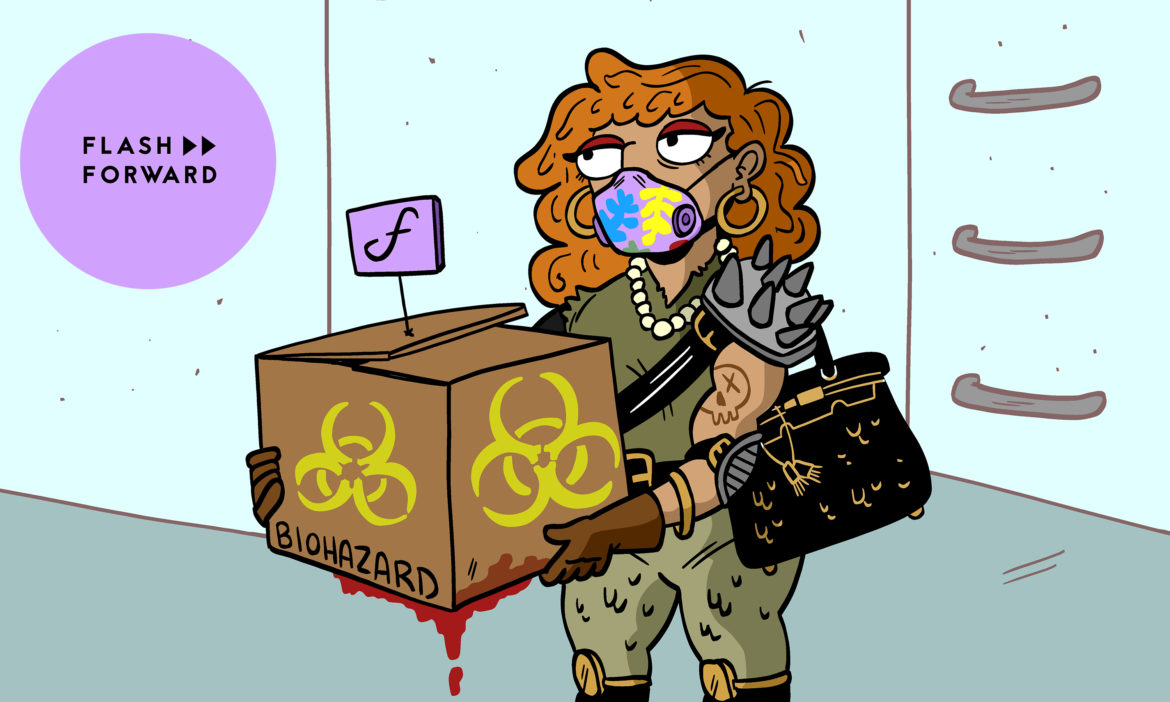

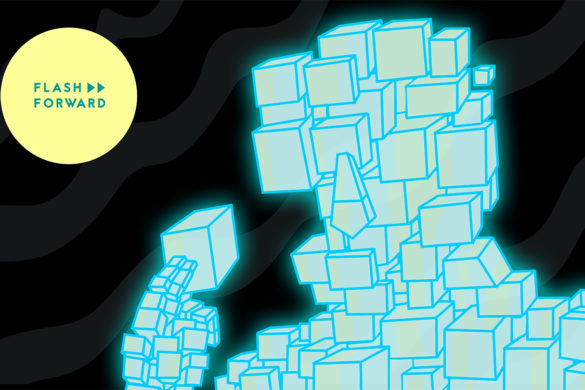
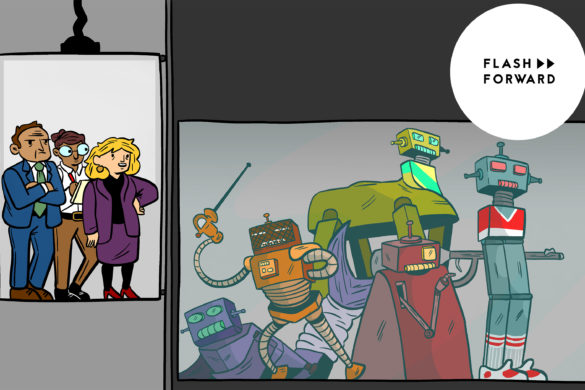
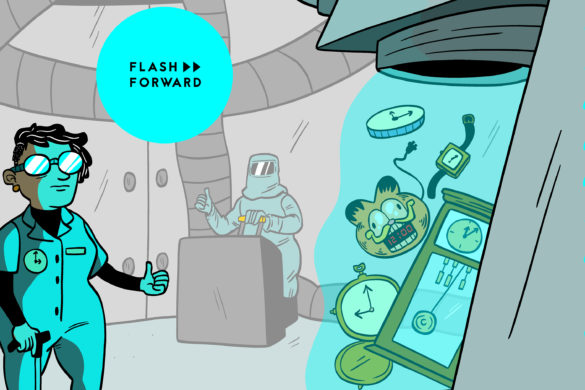
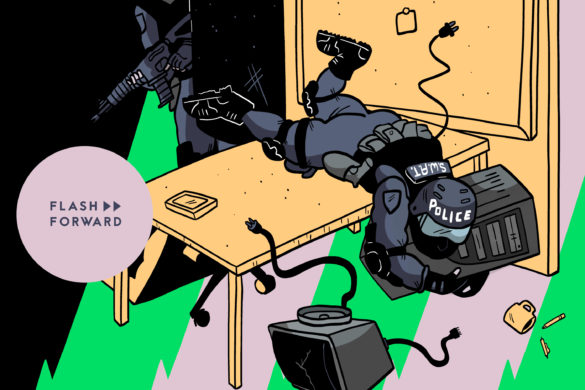
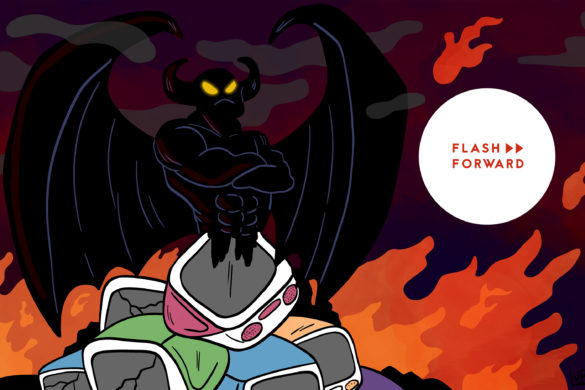

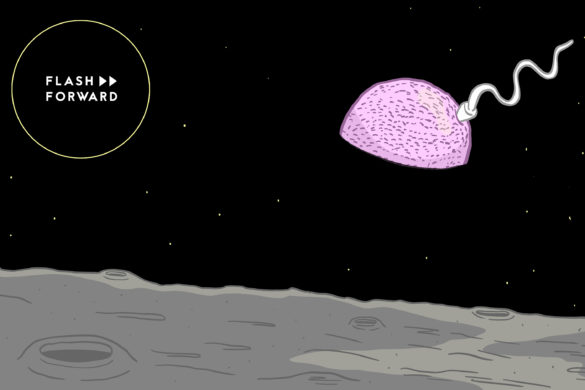
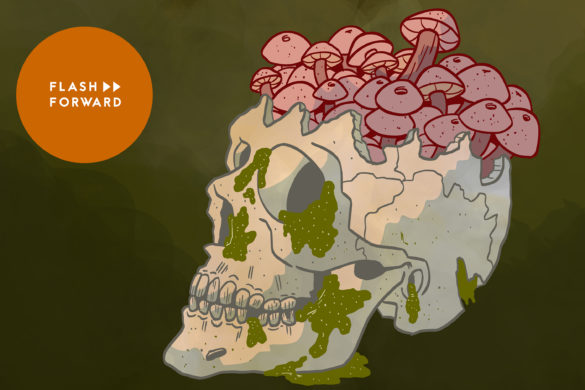

1 comment
[…] EARTH: The Desert Creep […]